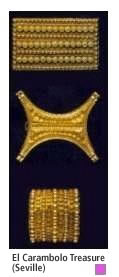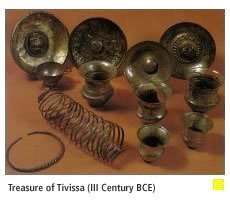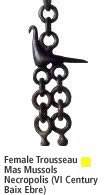
The arts of the Iberian civilization

The Iberian tribes of the Southeast of the peninsular and Andalusia were themselves organized into elitist societies, governed by kings made wealthy by the monopoly of trade with seagoing peoples, who arrived at these places before the end of the second millennium BCE. For that reason big funerary monuments and major hoards of gold jewellery have been found in those regions, but not in Catalonian territory.
The reason for this difference is, as explained above, that the Iberian Catalan society was much more egalitarian, with a fairer distribution of wealth, meaning that the few could not amass material goods and political power, which would enable them to be ostentatious with jewellery or to have major funerary monuments after their death.
Up until now we have only found two examples of sculptures from the Iberian epoch in Catalonia, both more interesting for their anthropological and historic value than any artistic value in itself.
The first is a fragment of a monument representing a seated divinity on a throne, at the side of which there is a relief as decoration with carved heads.  The connected pottery inside of the silo where it was discovered means we can date the piece as being from Can Posastres (Sant Marti Sarroca) between the III-II Century BCE. The other find was in 1985 in Malla (Osona) and also consists of reliefs in stone forming part of a monument, possibly of funerary character, and clearly classical influence. One of the two fragments shows a chariot, pulled by two horses and two figures with tunics standing on the chariot. The other fragment shows a fight between a centaur and a man.
The connected pottery inside of the silo where it was discovered means we can date the piece as being from Can Posastres (Sant Marti Sarroca) between the III-II Century BCE. The other find was in 1985 in Malla (Osona) and also consists of reliefs in stone forming part of a monument, possibly of funerary character, and clearly classical influence. One of the two fragments shows a chariot, pulled by two horses and two figures with tunics standing on the chariot. The other fragment shows a fight between a centaur and a man.
A very important aspect of the artistic production of the Iberians is goldsmithery. Even though Catalonia is not the area where the best and most important hoards of gold jewellery, chokers, earrings and bracelets have been found, there is one unique and extraordinary collection called the “treasure of Tivissa” consisting of two bracelets, ten whole glasses and fragments of others, decorated with embossed geometric motifs and vegetables, in silver, as well as the four famous pateras of gold-plated silver, decorated with wolf heads in high relief in the centre of the base, all discovered in Tivissa (Tarragona) at the beginning of the twentieth century.
 These objects of prestige denote the existence of an important place of worship in the village of Castellet de Banyoles, in Tivissa. The information they give us, together with their artistic quality make the pateras most interesting objects. One shows a scene of sacrifice and offering to a figure sitting on a throne, a rider on a horse with a lance and a lion attacking a herbivore, an item of ancient oriental origin, three
figures with wings and
a centaur It seems to be a funerary, sacrificial or religious item,and the most interesting point is the presence of those creatures with wings, daemons according to the Greeks, who were intermediaries between the gods and humans.
These objects of prestige denote the existence of an important place of worship in the village of Castellet de Banyoles, in Tivissa. The information they give us, together with their artistic quality make the pateras most interesting objects. One shows a scene of sacrifice and offering to a figure sitting on a throne, a rider on a horse with a lance and a lion attacking a herbivore, an item of ancient oriental origin, three
figures with wings and
a centaur It seems to be a funerary, sacrificial or religious item,and the most interesting point is the presence of those creatures with wings, daemons according to the Greeks, who were intermediaries between the gods and humans.
 This collection can be dated from the II Century BCE. because of the syncretism between the Greek, Roman and Iberian beliefs
Among the objects of everyday use, we must mention the fibulas or safety pins, which were very frequently used to fasten clothes, especially coats, so these elements are often found on archaeological excavations.They are usually bronze and might have some decoration such as coral pearls.
They were worn by both women and men, and the size depended on the thickness of the material they had to fasten.
This collection can be dated from the II Century BCE. because of the syncretism between the Greek, Roman and Iberian beliefs
Among the objects of everyday use, we must mention the fibulas or safety pins, which were very frequently used to fasten clothes, especially coats, so these elements are often found on archaeological excavations.They are usually bronze and might have some decoration such as coral pearls.
They were worn by both women and men, and the size depended on the thickness of the material they had to fasten.
The most typical Iberian fibula was one called annular fibula, circular in shape, used between V and I Centuries BCE, which means it was in fashion for about five hundred years (a real success!).From then on the fibulas disappeared, becoming obsolete as the Romans introduced the toga, a new fashion.